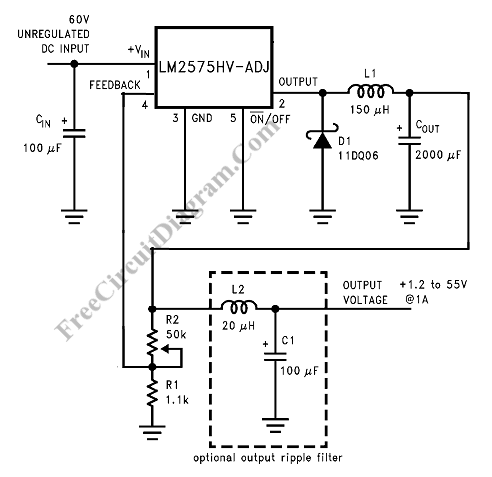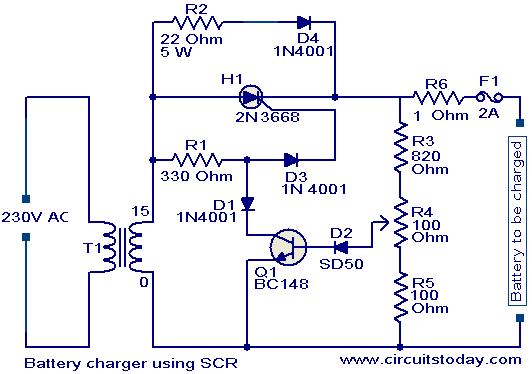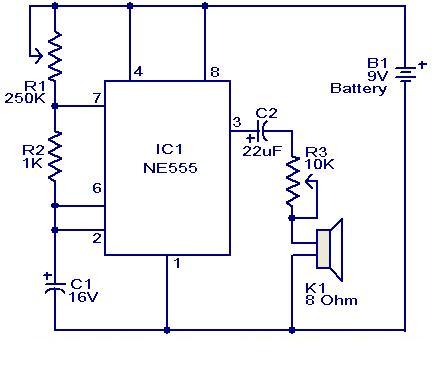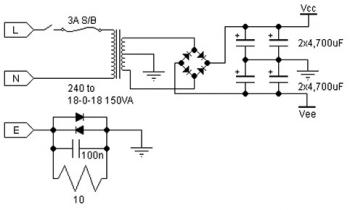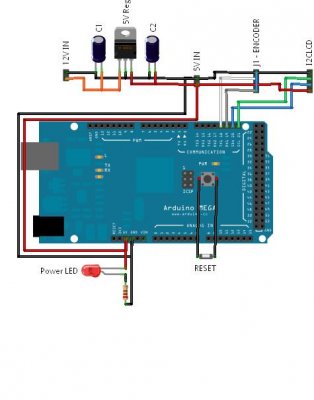
Police siren using NE555
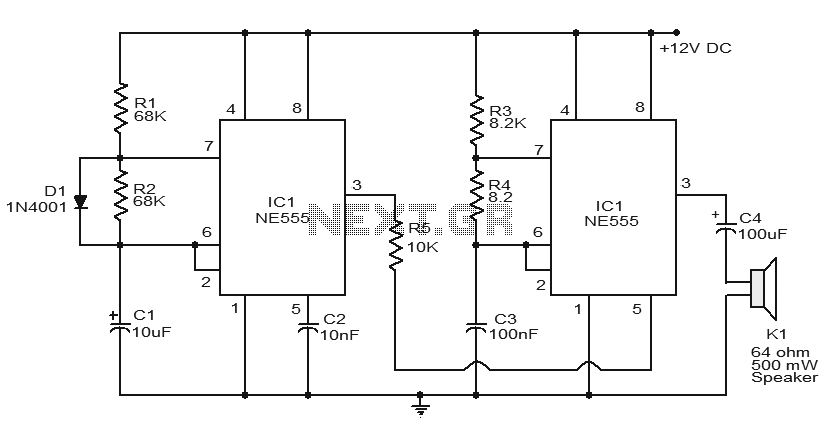
Numerous electronic circuits utilizing the NE555 timer IC have been published, and this is yet another example. The circuit diagram presented illustrates a police siren based on the NE555 timer IC. It employs two NE555 timer ICs, each configured as astable multivibrators. The circuit can be powered by a DC source ranging from 6 to 15V and produces a relatively loud sound. By connecting an additional power amplifier to the output, the volume can be further increased. IC1 is configured as a slow astable multivibrator operating at approximately 20Hz with a 50% duty cycle, while IC2 is set up as a fast astable multivibrator operating at around 600Hz. The output from the first astable multivibrator is connected to the control voltage input (pin 5) of IC2. This connection allows the output of IC2 to be modulated by the frequency output of IC1, thereby creating a siren effect. In simpler terms, the output frequency of IC2 is controlled by the output of IC1. For those who may not fully understand the workings and fundamentals of the NE555 IC, an online bookstore has been provided, featuring three detailed book reviews with links to purchase them online.
The described circuit utilizes the NE555 timer IC in a dual configuration to create a police siren sound. The first timer, IC1, operates as a slow astable multivibrator, generating a low-frequency square wave at approximately 20Hz. This frequency is suitable for producing a slow, wailing sound characteristic of a police siren. The duty cycle of 50% ensures that the high and low states of the output waveform are equal, contributing to a balanced sound output.
IC2, the second timer, is configured as a fast astable multivibrator, generating a higher frequency square wave at around 600Hz. This high-frequency signal is essential for adding a rapid modulation effect to the siren sound. The output from IC1 is fed into the control voltage input (pin 5) of IC2, allowing the slower frequency of IC1 to modulate the faster frequency of IC2. This interaction results in a dynamic sound that simulates the rising and falling pitch of a siren.
The power supply for this circuit can vary between 6V and 15V DC, making it versatile for different applications. The output can be further amplified by connecting an external power amplifier, which enhances the loudness of the siren effect, making it more suitable for practical use in alarm systems or other signaling applications.
For individuals seeking to deepen their understanding of the NE555 timer IC, a selection of three recommended books is available for purchase online. These resources provide comprehensive insights into the operation, applications, and various projects involving the NE555 timer, catering to both beginners and advanced users.A lot of electronic circuits using NE555 timer IC are already published here and this is just another one. Here is the circuit diagram of a police siren based on NE55 timer IC. The circuit uses two NE555 timers ICs and each of them are wired as astable multivibrators. The circuit can be powered from anything between 6 to 15V DC and is fairly loud. By connecting an additional power amplifier at the output you can further increase the loudness. IC1 is wired as a slow astable multivibrator operating at around 20Hz @ 50% duty cycle and IC2 is wired as fast astable multivibrator operating at around 600Hz. The output of first astable mutivibrator is connected to the control voltage input (pin5) of IC2. This makes the output of IC2 modulated by the output frequency of IC1, giving a siren effect. In simple words, the output frequency of IC2 is controlled by the output of IC1. For all of you who do not have a clear understanding of the working and basics of the NE555IC, we have provided an online book store for you.
Here 3 books are reviewed in detail with links to buy the books online itself. Get your copy now by clicking here:- 3 Great Books to Learn 555 Timer Circuits and Projects 🔗 External reference
The described circuit utilizes the NE555 timer IC in a dual configuration to create a police siren sound. The first timer, IC1, operates as a slow astable multivibrator, generating a low-frequency square wave at approximately 20Hz. This frequency is suitable for producing a slow, wailing sound characteristic of a police siren. The duty cycle of 50% ensures that the high and low states of the output waveform are equal, contributing to a balanced sound output.
IC2, the second timer, is configured as a fast astable multivibrator, generating a higher frequency square wave at around 600Hz. This high-frequency signal is essential for adding a rapid modulation effect to the siren sound. The output from IC1 is fed into the control voltage input (pin 5) of IC2, allowing the slower frequency of IC1 to modulate the faster frequency of IC2. This interaction results in a dynamic sound that simulates the rising and falling pitch of a siren.
The power supply for this circuit can vary between 6V and 15V DC, making it versatile for different applications. The output can be further amplified by connecting an external power amplifier, which enhances the loudness of the siren effect, making it more suitable for practical use in alarm systems or other signaling applications.
For individuals seeking to deepen their understanding of the NE555 timer IC, a selection of three recommended books is available for purchase online. These resources provide comprehensive insights into the operation, applications, and various projects involving the NE555 timer, catering to both beginners and advanced users.A lot of electronic circuits using NE555 timer IC are already published here and this is just another one. Here is the circuit diagram of a police siren based on NE55 timer IC. The circuit uses two NE555 timers ICs and each of them are wired as astable multivibrators. The circuit can be powered from anything between 6 to 15V DC and is fairly loud. By connecting an additional power amplifier at the output you can further increase the loudness. IC1 is wired as a slow astable multivibrator operating at around 20Hz @ 50% duty cycle and IC2 is wired as fast astable multivibrator operating at around 600Hz. The output of first astable mutivibrator is connected to the control voltage input (pin5) of IC2. This makes the output of IC2 modulated by the output frequency of IC1, giving a siren effect. In simple words, the output frequency of IC2 is controlled by the output of IC1. For all of you who do not have a clear understanding of the working and basics of the NE555IC, we have provided an online book store for you.
Here 3 books are reviewed in detail with links to buy the books online itself. Get your copy now by clicking here:- 3 Great Books to Learn 555 Timer Circuits and Projects 🔗 External reference

